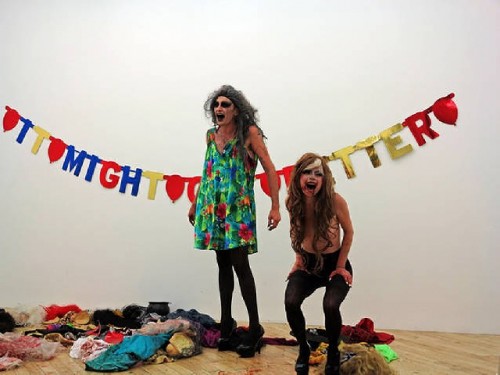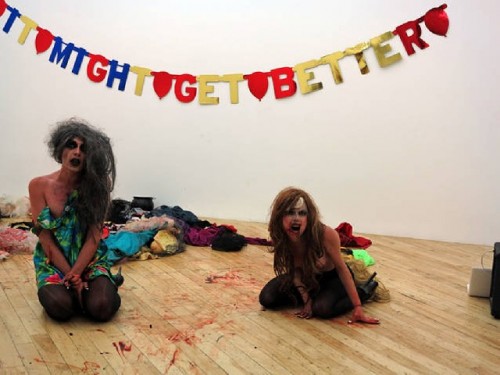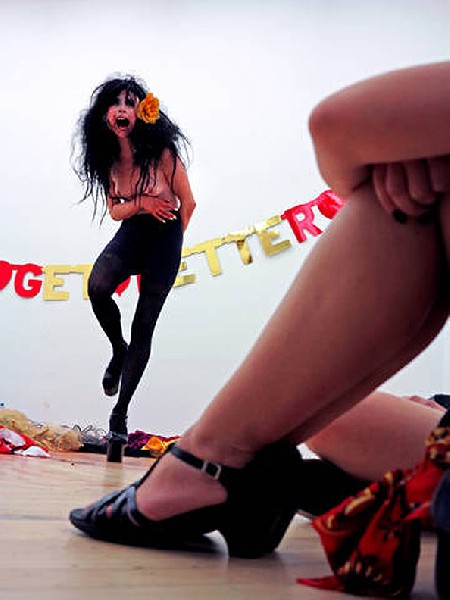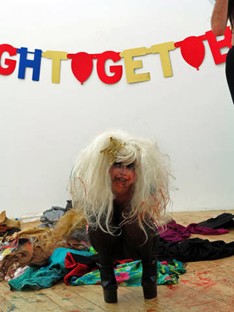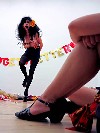Morgenstern and Baxter at Anthony Greaney Gallery
Queer Performance Moves Critic to Tears
By: David Bonetti - Jul 20, 2012
Sad movies sometimes make me cry – perhaps most dramatically the time I pulled over into the breakdown lane on an Interstate in nowhere Christian Missouri and bawled for 20 minutes in a delayed reaction to seeing “Brokeback Mountain.”
But I am more likely to cry in opera. Jet lag helps – I sobbed uncontrollably during a production of “Norma” at the Opera Bastille with June Anderson and Sonia Ganassi, which I attended just hours after landing in Paris on a flight from San Francisco. But jet lag had nothing to do with my response to Violetta’s death scene in a long-ago Sarah Caldwell production of “La Traviata,” starring Beverly Sills, or to Lorraine Hunt’s incandescent version of Dido’s lament, “When I am laid to rest,” in Mark Morris’s “Dido and Aeneas” at the Cutler Majestic Theatre. In both cases, half the audience was also in tears.
I don’t think I’ve ever cried during a piece of performance art, however. That changed during the July First Friday openings on Thayer Street when recent MFA Museum School grads Hayley Morgenstern and Creighton Baxter performed their graduate thesis piece “It Might Get Better” at the Anthony Greaney Gallery. I hadn’t seen such coruscating queer performance art since I left San Francisco in 2003 – there wasn’t much of it to see in St. Louis - and I saw precious few examples of it in the City by the Bay that were as conceptually rigorous and emotionally raw, Justin Bond’s and Kenny Mellman’s sometimes-ferocious performances of “Kiki and Herb,” the prime exceptions. That Bond has gone on to fame and fortune in New York and London suggests that there could be a shining future for Morgenstern and Baxter if they don’t kill themselves in the process of performing their unforgiving vision of art. Unforgiving in two senses: of the audience, many of whom flee, unable to take it – and I can understand that response - and, more critically, of themselves.
Oh, yeah, the crying. The performance featured the two artists singing along with mad intensity to recordings of songs by five contemporary female pop music divas – JoJo, Meredith Brook, Fiona Apple, Whitney Houston and, of course, the late, great Amy Winehouse - that alternately addressed female abjectness and empowerment. As they shrieked and wailed, effectively drowning out the recordings, they changed costume from a heap of rags and pile of wigs on the floor. Periodically they would spew from their mouths a viscous black liquid that would pour down their chins, onto their garments, finally puddling on the floor. Every time they came to Whitney Houston’s “I Will Always Love You,” one of the great sentimental, i.e., kitsch, songs of the past half-century, I cried. Toward the end of the performance, I had to leave the gallery and watch through the windows from the sidewalk. All I could think of was Whitney, beautiful Whitney with that dazzling smile, drowning in the bathtub of an expensive hotel, od’ing on pills and booze while her handlers partied in the room outside.
It sure ain’t easy being a woman – with the exception of the two shepherds in “Brokeback Mountain,” that’s what all the artists who have made me cry, deal with. And the characters Jack Twist (Jake Gyllenhaal) and Ennis Del Mar (Heath Ledger) suffered, and in Twist’s case, died, by defying in their own inarticulate ways the same iron-clad laws of machismo that also have kept women down for centuries in this culture and in others.
And that’s what much of queer art – not gay art, which today is middlebrow, middle class and meliorative – is about: The oppression of women and, by extension, men who refuse to play hetero-normative sex and social roles, and their different responses to that situation from succumbing to societal demands, often ending in death - sometimes suicide - or by resisting.
The fact that queer artists, male as well as female, have embraced feminism might be a shock to members of the older generation who remember drag queens as horrifyingly misogynistic creatures of the night, Boston’s famous Silvia Sydney, who hated women almost as much as she hated herself, the perfect example.
The title of the piece, “It Might Get Better,” which hung in a string of multi-colored party letters on the wall of the gallery behind the performers, is a rhetorical retort to the gay-teen anti-suicide campaign, “It Gets Better,” led by uxorious sex columnist Dan Savage. Oh, does it? Gets better, does it? Isn’t that a little Pollyannaish? “Might” might even be too optimistic. In the meantime, we scream and drip black blood and double over into ourselves as if we’ve just been raped.
Morgenstern and Baxter, both of whom were anorexic thin, performed as if they were singing one long song. Each time the set looped around again, they sang the individual songs so differently that it only gradually dawned on me that they were singing the few short songs over and over again. Meredith Brook’s assertive “Bitch” - (I’m a bitch, I’m a lover/I’m a child, I’m a mother/I’m a sinner, I’m a saint/I do not feel ashamed”) - merged seamlessly with Winehouse’s familiarly depressive lyrics to “Back to Black,” which in turn blended into Fiona Apple’s cold, cruel “Criminal” – (“I’ve been a bad, bad girl/I’ve been careless with a delicate man/And it’s a sad, sad world/when a girl breaks a boy just because she can”) - which then bleeds into Houston’s anthem of dependent love. Despite the defiance, they are all variations on the theme of love, the female opium, even after waves of feminist thought and action. Hey, didn’t Gloria Steinem date some of the biggest pigs in New York? Like Mort Zuckerman?? (I wonder if she wore her bunny ears and tail when she shagged him.) Steinem was addicted to the money and the power that accompanies it. A habit set over millennia is hard to break.
The performance was visceral. This was the scream of woman from Eve on down the line. But it was informed by art, theater and critical theory. The etiolated images of bodies in distress by anxiety-defining artists like Egon Schiele were given flesh and blood and made to move and sing. Grotowski’s theory of a poor theater and Italian arte povera, both relics from the ‘50s and ‘60s, were plugged into and brought back to life. Charles Ludlam’s Theater of the Ridiculous provided a strong queer precedent. The primary image of the performance most strongly reminded me of “Venus of Rags,” a 1967 assemblage by arte povera maestro Michelangelo Pistoletto of a plaster Venus rising from a flood of rags. With the black bile running down their chins Morgenstern and Baxter took on the role of thrift store Venuses from Hell.
The simple written statement that accompanied the performance was a quotation from U-Penn English prof, Heather Love (real name?): “The value of some aspects of historical gay identity – deeply ideological though they may be – have (sic) been diminished or dismissed with successive waves of liberation. Central among these is the association between homosexual love and loss – a link that, historically, has given queers insight into love’s failures and impossibilities (as well as, of course, wild hopes for its future). Claiming such an association rather than disavowing it, I see the art of losing as a particularly queer art.”
The married real estate kweens who parade their newly purchased babies down Commercial Street in Provincetown or on Tremont Street in the South End might not like that idea, but it might be realer than their very banal fantasies of normality.


